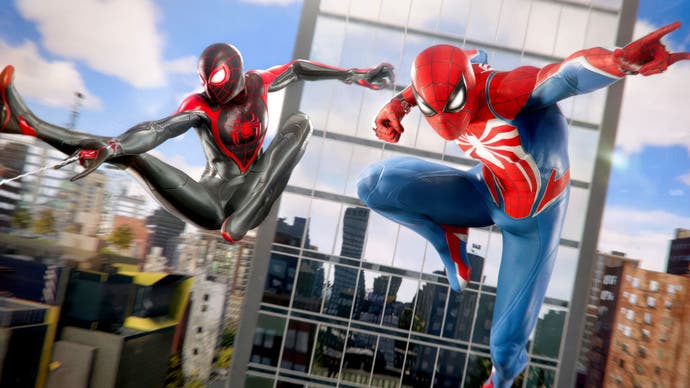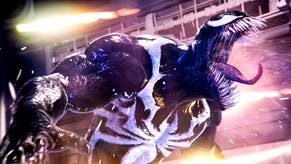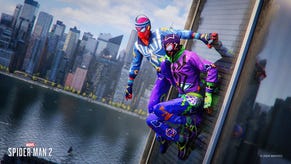Marvel's Spider-Man 2: the next big leap for PlayStation 5?
A new showcase for visual detail, ray tracing - and the PS5 SSD.
On the eve of PlayStation 5's three-year anniversary, Insomniac Games has returned with a new Spider-Man adventure. Built for PlayStation 5, Marvel's Spider-Man 2 expands on the Insomniac's in-house technology, delivering a game with a larger scope and a brand-new spider plot to follow. The title in this case couldn't be more apt with players swapping between the two Spider-Men seamlessly over the course of the story as you explore a greatly expanded game world. In DF tradition then, I wanted to break down this game's new visual and gameplay features highlighting the positives and negatives along the way. At first glance it may feel familiar but, trust me, there is a lot here to unpack.
The release of Marvel's Spider-Man 2 marks Insomniac's fourth game shipped on PS5, following Miles Morales, Spider-Man Remastered and Ratchet and Clank. It's a level of production efficiency that continues to impress and Spider-Man 2 is perhaps the largest production of the four, expanding the size and scope of the world while doubling down on granular detail. With Miles, there were two major innovations brought to the table on PS5 back at launch: fast loading and ray-traced reflections. Both of these features return in Spider-Man 2 and each have received numerous improvements, allowing scenarios to exist which were not possible in prior entries.
Like Miles before it, Spider-Man 2 loads quickly. Fire up the game from the PS5's home menu and you're dropped back into the game world within seconds. It almost feels as if the game was simply suspended in the background, yet it loads with minimal delay. They've also leveraged these technologies in additional ways to enhance the experience beyond what was possible in the cross-gen prequels.
The first of these is traversal speed. There's a moment during the game's intro sequence where Sandman grabs Spider-Man and hurls him across the map. The speed at which this occurs is disarming at first - despite this ultra-dense urban location, the game seems to effortlessly handle flying across the map. Soon afterwards, you're given access to the Web Wings which completely changes the pace of traversal. While swinging remains Spider-Man's primary means of transport, you can now tap triangle to spread your wings and fly. It reminds me of Super Mario World's cape mechanic, but what it really highlights is what the boost in speed made possible. Flying across the map while trying to maintain altitude creates a similar feeling that you get from using the manual to link combos in Tony Hawk's Pro Skater.
This also enables the developers to pull of some pretty fancy transitional tricks. For example, after completing a mission as Miles, the game camera seamlessly pulls away and soars across the city before parking itself near a perch waiting for Peter. Both the speed of flight and the camera work itself are tremendous. Basically, you can now move directly across the world at high speed - something of a worst-case scenario for the game's level of detail system - yet somehow, it all manages to feel remarkably stable.
The level of visible detail has been pushed out significantly, in fact. There now seems to be a mid-point between the full near-field detail and distant LODs. As a result, the world density and detail are boosted, with less in the way of flat buildings and pop-in.
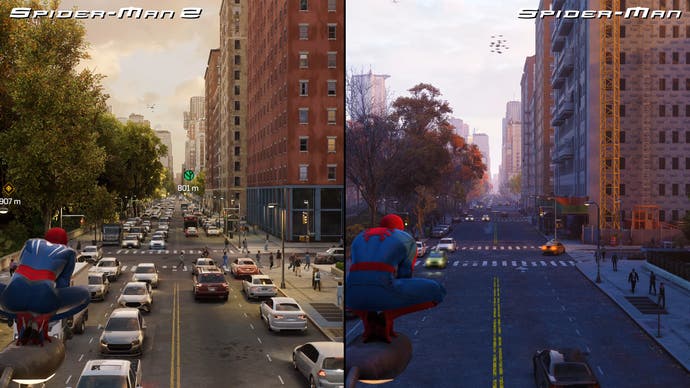
In the near field, I found that Spider-Man 2 presents a more densely populated world than the original game with more cars and pedestrians, giving the impression of a more lively, inhabited city. Just walking down the street reinforces this perception and it represents a nice improvement. However, there's more to this - distant detail and variety have been greatly enhanced too. If you look out across the city, for instance, you can see additional geometric detail as well as an increase in material variety. The game manages to shake that feeling of countless textured boxes serving as the city.
I think this is why initial reactions to the trailers were mixed - it still very much looks like the prior games artistically, but once you actually get in there and look closely, it becomes clear that they've taken this design and pushed out detail across the board.
I also noticed things like improved large-scale occlusion - the area beneath trees, for instance, appears properly darkened and shadowed in Spider-Man 2, as you would expect from an area shrouded in vegetation. The fact that all of this detail is loaded without significant visible pop-in really impresses - the game world just feels stable.
The other area where the game's fast loading systems are used might be familiar to fans of Ratchet and Clank. There, Insomniac showed off impressive portal jumping sequences, though when you entered a portal connecting two environments, there was a staging period between the two where Ratchet floats in space.
In Spider-Man 2, they've overcome this limitation and there are multiple points where portals are used to allow players to seamlessly move between worlds. It's an impressive accomplishment. When considering the speed of traversal, fast loading and an increased level of detail, this feels like a game that simply wouldn't have been achieveable on the last-gen PS4 - but the PS5's SSD and I/O in general work wonders.
The other major feature that Insomniac pushed with Miles back at launch is ray-traced reflections. Unlike their prior three games, however, Insomniac made the decision to put ray tracing in every mode in Spider-Man 2 - with no option to disable it. I feel this is a positive step forward and allowed the development team to embrace certain decisions around the presentation without worrying about fallbacks. It's essential for a game packed with gleaming skyscrapers and reflective surfaces galore. It almost feels like revenge for the 2018 Puddlegate situation, if you remember that one.
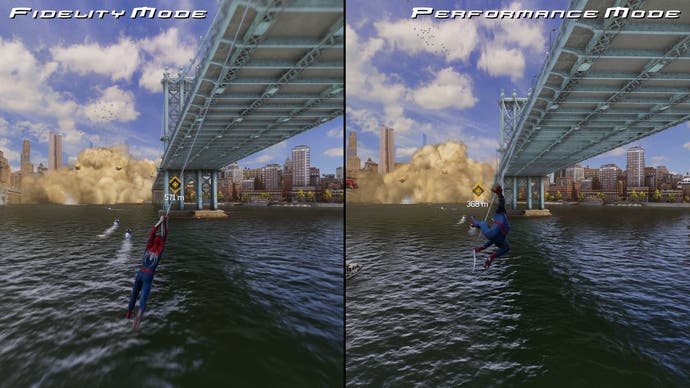
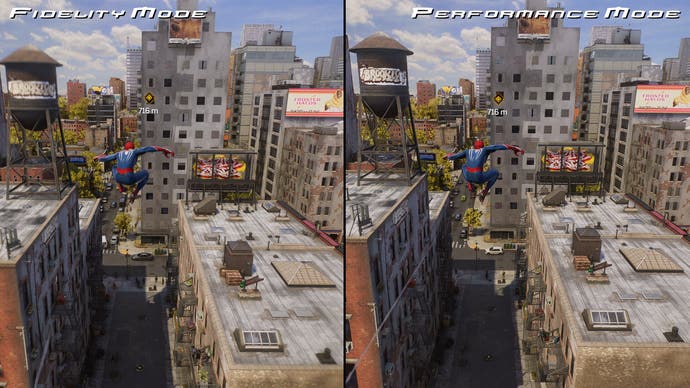
Before we dig into the improvements to the RT reflections, however, perhaps I should spell out exactly what modes are on offer - because this robust model is one I'd like to see other games follow.
Spider-Man 2 includes both a performance and quality mode, which each deliver a stable frame-rate. In addition, there are also options for 60Hz or 120Hz output, with the 120Hz output setting unlocking a 40fps quality mode in addition to the standard 30fps quality mode. Both quality modes use dynamic resolution scaling, ranging from 1440p to 4K. Insomniac's temporal injection is used to handle anti-aliasing duties as usual. Performance mode is 60fps, with dynamic resolutions ranging from 1008p to 1440p.
Finally, there are three bespoke VRR modes - off, smooth or uncapped. Off is obvious but smooth versus uncapped is interesting. Smooth essentially uses VRR to smooth the presentation while retaining the frame-rate cap, while uncapped allows the frame-rate to run free. That means, in performance mode, the frame-rate can go above 60fps, normally 65-80fps, while quality mode is normally 40-60 fps. When using the uncapped performance mode, the game's resolution can drop to an absolute minimum of 936p as a worst-case scenario, but other modes won't drop to this point.
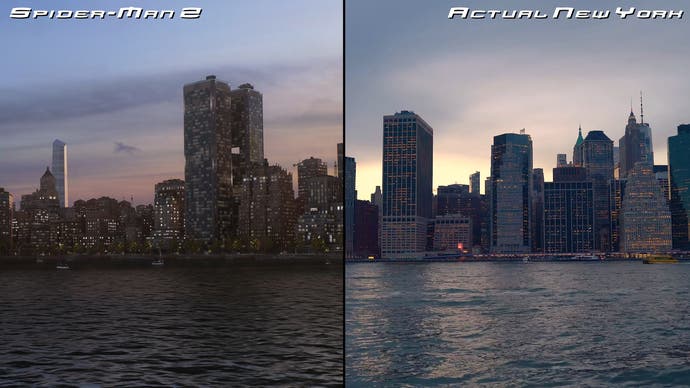
We'll have more to say on this at launch when trying to stress the performance but the key is that Spider-Man 2 offers players plenty of choice when it comes to image quality versus performance. For my money, I prefer the 40fps mode as it strikes a perfect middle ground.
Now, let's get back to the RT decision and its implications: if all modes feature ray tracing, what does this mean for the visuals? Why did they make this decision?
I think part of this ties into the new, larger map and specifically, its water. It's now possible to cross the river, visiting a much larger slice of New York including Queens and Brooklyn. What this means for the player is that you'll spend a lot more time crossing the river. Thus, for Spider-Man 2, Insomniac opted to extend RT reflections to all bodies of water as well. Water reflections can be challenging, however, as the nature of choppy water means a high, computationally-expensive roughness value. Prior Insomniac games relied exclusively on screen space reflections for rougher surfaces to save on performance, so this is a big departure.
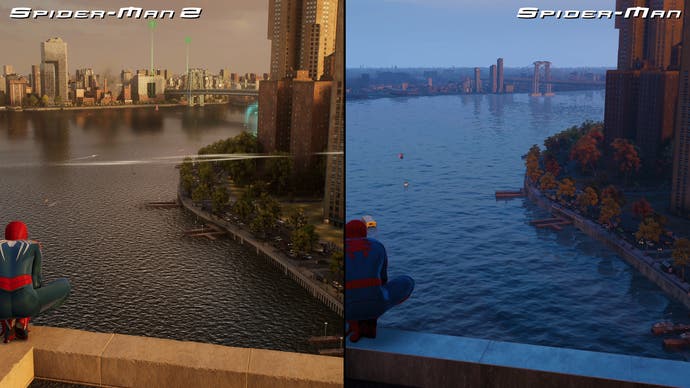
Comparing Spider-Man to its predecessors, the benefits become obvious - distant environments receive more precise and realistic reflections in Spider-Man 2. More importantly, there are no disocclusion artefacts - eg things occluded by the player character not showing up in reflections - as is the norm with SSR.
Ray tracing is also applied to smaller bodies of water such as ponds and streams in Central Park - given the calmness of the water in these scenarios, the reflections appear more mirror-like in Spider-Man 2.
This isn't the only enhancement to RT reflections either. Firstly, secondary reflections have been implemented - eg glass that is reflected within glass shows its own reflection based on its angle. In Miles and Spider-Man Remastered, this wasn't the case, and the secondary reflection was basically just a color. In Spider-Man 2, however, reflections of reflections are now visible if you look closely.
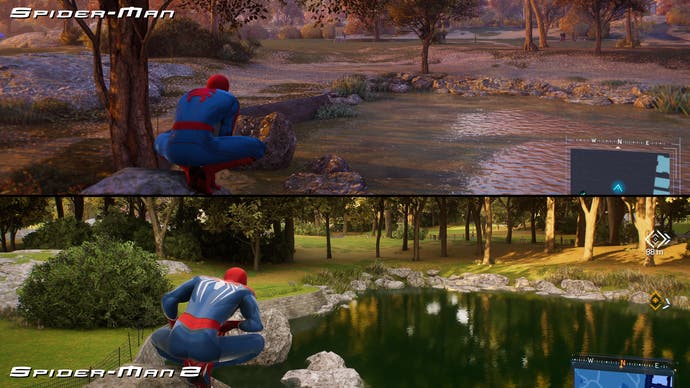
Secondly, VFX are now rendered using ray tracing. So, things like explosions, particles and clouds of smoke are all drawn within the game's reflective surfaces. There are also simply more objects included within the BVH structure now the reflections are more accurate to the surrounding environments. They're also just higher quality with less smearing and fizzle.
For my money, it's the best example of ray-traced reflections you'll find in an open world console game as of 2023. Nothing else comes close.
If you look beyond the reflections, you'll discover another major improvement - interior spaces. The prior Spider-Man games relied on cube maps to fake the illusion of a 3D space within the building structures, as it's computationally expensive to render a bunch of individual cubes through transparent windows, each with their own geometry, lighting and shadows. You could use portals mapped to a texture for this, but it would be way too expensive with so many rooms.
Spider-Man does things differently. After looking closely at these rooms, I noticed that the internal room geometry presents with obvious checkerboarding artefacts and more visible aliasing, versus the clean geometric edges surrounding the window. And where have we seen these characteristics before? Why, the ray traced reflections, of course.

So, given this evidence, I think that Insomniac is leveraging its RT support to create these virtual spaces. Perhaps they've created multiple rooms stored within the BVH structure and, by tracing into these rooms based on information gleaned from a ray hitting the glass surface, they could then figure out lighting, shadows and more. One thing is for sure - this is a remarkably elegant solution to a difficult problem.
Other enhancements include an increased density of real-time lights pushed further into the distance and more times of day to experience variable weather conditions.
Pre-calculated large-scale animations are also in full effect - similar to alembic animations where complex sequences can be played back in real-time during gameplay, allowing for some impressive scripted scenes. This investment in animation work makes a big statement, right from the introduction sequence.
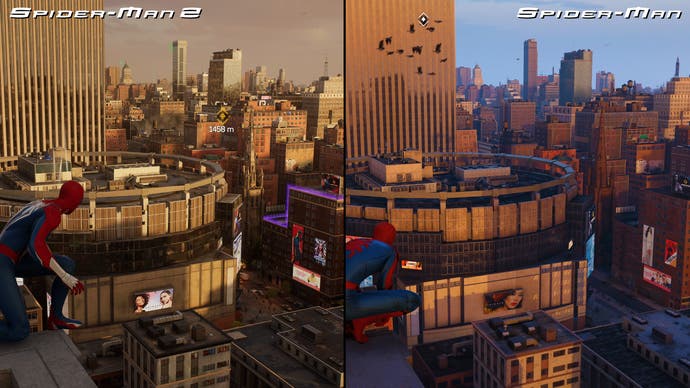
Of course, many of the excellent features introduced in their prior games make a full return. The strand hair system, for instance, is used heavily in this game and the main characters sport exceptionally detailed locks. The illusion remains strong even when zooming way in. What's most impressive about it is the variety of hairstyles on display - all of them look excellent, even long and flowing hair which tends to be tricky to render without clipping issues.
Character model detail in general is simply excellent too, and things like the muscle simulation system that was added via a patch to Miles Morales is also used here - so Spider-Man's suit will change based on muscle movement.
Speaking of the suit, the detail level remains exceptionally high, but what really caught my attention are the symbiote elements - the procedural animation system they've built to support this is remarkable, perfectly capturing its organic slithering.
Clothing also benefits from cloth simulation and variety - I was surprised to see that characters would often wear completely different outfits from day-to-day as they appeared in cutscenes which is a nice touch. The shell texture fur shading is also back and used both on clothing and things like carpets in certain scenes.
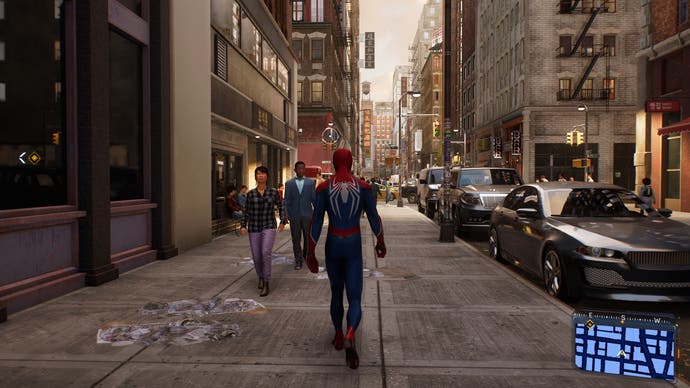
That said, I do have a couple nitpicks that I also wanted to present - in select circumstances, I encountered visible texture seams which look a little off. Secondly, the sand particle clouds used for Sandman look a little off to me - like typical flat billboard smoke. When in close proximity, they kick in the volumetric effects, which do look awesome, but from a distance, it doesn't blend perfectly with the scenery.
I also encountered a bug once where a defeated enemy went into a horizontal t-pose and floated up through the scenery towards the heavens. The game was patched since that occurred, I should note, and it was the only bug I encountered - but it was funny.
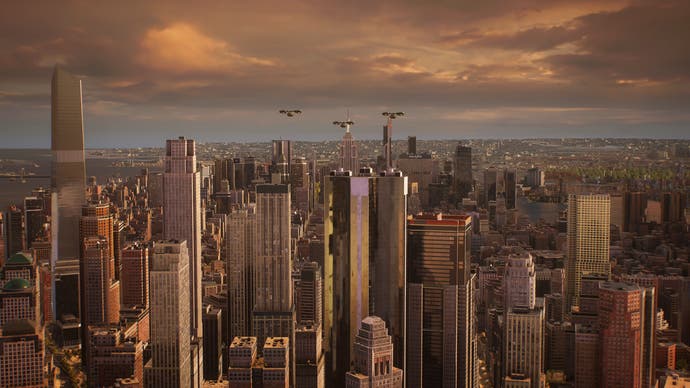
Really though, these are just tiny nitpicks in what is an otherwise gorgeous game.
Of course, another aspect of the presentation is the audio - this is more difficult to showcase in a written article, but it's worth mentioning that the surround sound experience is sublime, with great use of the rear and height channels thanks to the system's support for Atmos output.
Sound propagation has also been added so sounds and voices are influenced by their position in the world. Sound also varies based on the environment type, which is often subtle but still adds an extra layer of realism to the presentation that is appreciated.
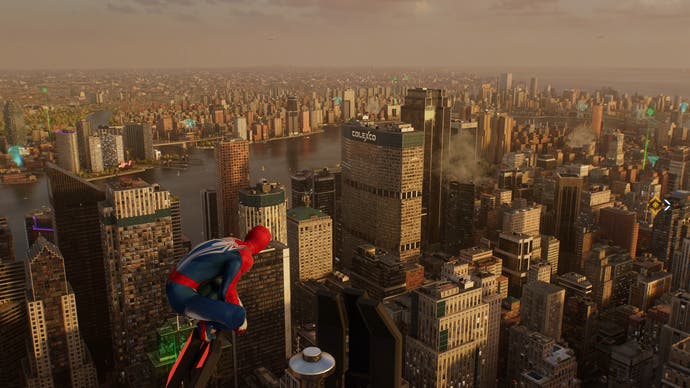
I think the tech powering Spider-Man 2 is excellent, and a nice evolution of Insomniac's work on prior games. While it doesn't completely rewrite the visual identity of the game, what's here looks great and there are noticeable leaps over the last-generation games.
In terms of the game itself, the developers have done an excellent job there as well. Early on you're introduced to side missions, similar to the original, but I found that it's easier to stick to just the main storyline if that's what you're most interested in. The side missions that are here do offer increased variety, mind you, but the main story is what has me excited the most. The story-telling is also on point; this is, without a doubt, the best story Insomniac has told in a game to date. It's beautifully executed and, as a fan of Die Spinne, I was delighted with how things play out.
So, if you're also a fan of the Spider and happen to own a PS5, you're in for a treat. The game is great, the technology is impressive and the whole package is remarkably polished. It's been a tough year for big game releases, in terms of polish, but Insomniac nailed it with Spider-Man 2.
